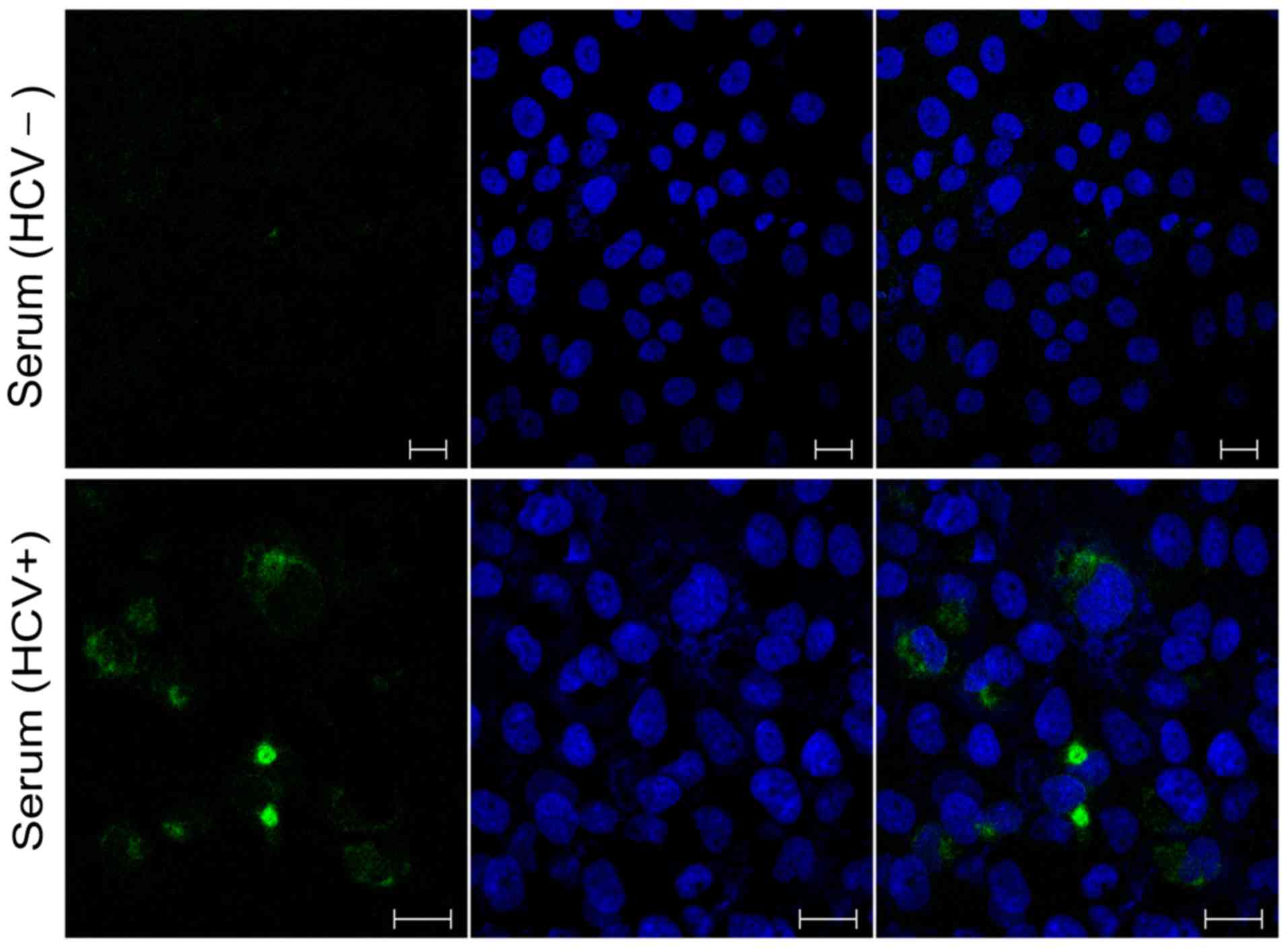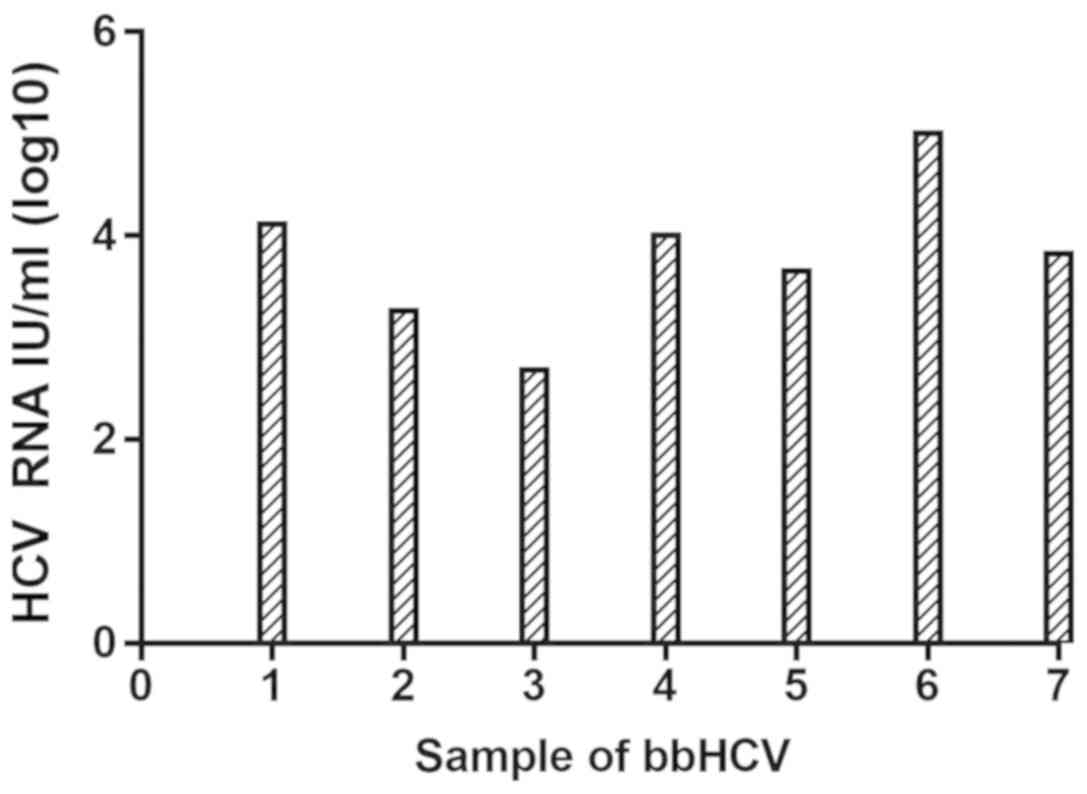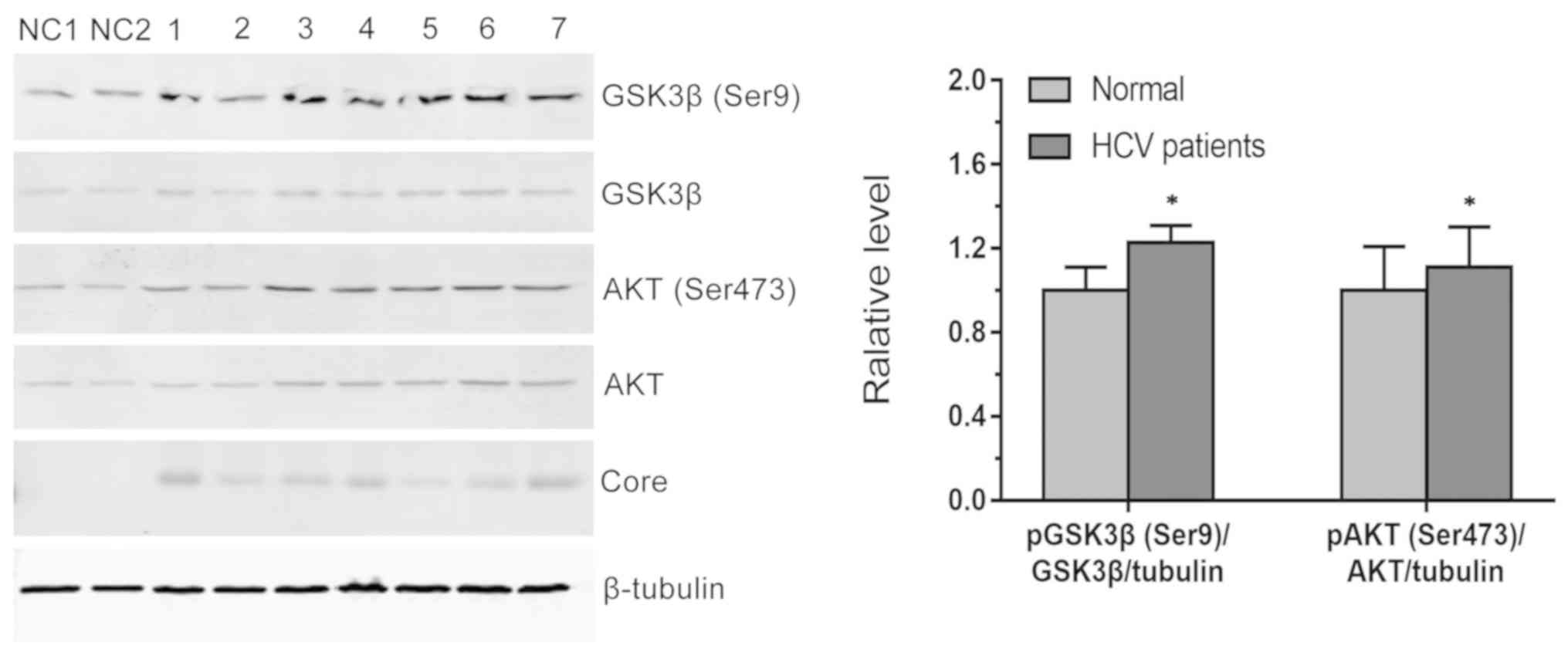|
1
|
European Association for the Study of the
Liver. Electronic address, . easloffice@easloffice.eu: EASL
recommendations on treatment of hepatitis C 2016. J Hepatol.
66:153–194. 2017. View Article : Google Scholar : PubMed/NCBI
|
|
2
|
Mohd Hanafiah K, Groeger J, Flaxman AD and
Wiersma ST: Global epidemiology of hepatitis C virus infection: New
estimates of age-specific antibody to HCV seroprevalence.
Hepatology. 57:1333–1342. 2013. View Article : Google Scholar : PubMed/NCBI
|
|
3
|
AASLD/IDSA HCV Guidance Panel: Hepatitis C
guidance: AASLD-IDSA recommendations for testing, managing, and
treating adults infected with hepatitis C virus. Hepatology.
62:932–954. 2015. View Article : Google Scholar : PubMed/NCBI
|
|
4
|
Dorner M, Horwitz JA, Donovan BM, Labitt
RN, Budell WC, Friling T, Vogt A, Catanese MT, Satoh T, Kawai T, et
al: Completion of the entire hepatitis C virus life cycle in
genetically humanized mice. Nature. 501:237–241. 2013. View Article : Google Scholar : PubMed/NCBI
|
|
5
|
Lorenz IC, Marcotrigiano J, Dentzer TG and
Rice CM: Structure of the catalytic domain of the hepatitis C virus
NS2-3 protease. Nature. 442:831–835. 2006. View Article : Google Scholar : PubMed/NCBI
|
|
6
|
Ahmad J, Eng FJ and Branch AD: HCV and
HCC: Clinical update and a review of HCC-associated viral mutations
in the core gene. Semin Liver Dis. 31:347–355. 2011. View Article : Google Scholar : PubMed/NCBI
|
|
7
|
Vandenbulcke H, Moreno C, Colle I, Knebel
JF, Francque S, Sersté T, George C, de Galocsy C, Laleman W,
Delwaide J, et al: Alcohol intake increases the risk of HCC in
hepatitis C virus-related compensated cirrhosis: A prospective
study. J Hepatol. 65:543–551. 2016. View Article : Google Scholar : PubMed/NCBI
|
|
8
|
Wang XF and Korangy F: Intrahepatic
landscape of regulatory T-cell subsets in chronically HCV-infected
patients with cirrhosis and HCC. Hepatology. 60:1461–1462. 2014.
View Article : Google Scholar : PubMed/NCBI
|
|
9
|
Wilkinson J, Radkowski M and Laskus T:
Hepatitis C virus neuroinvasion: Identification of infected cells.
J Virol. 83:1312–1319. 2009. View Article : Google Scholar : PubMed/NCBI
|
|
10
|
Mannová P and Beretta L: Activation of the
N-Ras-PI3K-Akt-mTOR pathway by hepatitis C virus: Control of cell
survival and viral replication. J Virol. 79:8742–8749. 2005.
View Article : Google Scholar : PubMed/NCBI
|
|
11
|
Mariotto S, Ferrari S and Monaco S:
HCV-related central and peripheral nervous system demyelinating
disorders. Inflamm Allergy Drug Targets. 13:299–304. 2014.
View Article : Google Scholar : PubMed/NCBI
|
|
12
|
Pham TN, MacParland SA, Mulrooney PM,
Cooksley H, Naoumov NV and Michalak TI: Hepatitis C virus
persistence after spontaneous or treatment-induced resolution of
hepatitis C. J Virol. 78:5867–5874. 2004. View Article : Google Scholar : PubMed/NCBI
|
|
13
|
Radkowski M, Gallegos-Orozco JF, Jablonska
J, Colby TV, Walewska-Zielecka B, Kubicka J, Wilkinson J, Adair D,
Rakela J and Laskus T: Persistence of hepatitis C virus in patients
successfully treated for chronic hepatitis C. Hepatology.
41:106–114. 2005. View Article : Google Scholar : PubMed/NCBI
|
|
14
|
Letendre S, Paulino AD, Rockenstein E,
Adame A, Crews L, Cherner M, Heaton R, Ellis R, Everall IP, Grant
I, et al: Pathogenesis of hepatitis C virus coinfection in the
brains of patients infected with HIV. J Infect Dis. 196:361–370.
2007. View
Article : Google Scholar : PubMed/NCBI
|
|
15
|
Weissenborn K, Ennen JC, Bokemeyer M, Ahl
B, Wurster U, Tillmann H, Trebst C, Hecker H and Berding G:
Monoaminergic neurotransmission is altered in hepatitis C virus
infected patients with chronic fatigue and cognitive impairment.
Gut. 55:1624–1630. 2006. View Article : Google Scholar : PubMed/NCBI
|
|
16
|
Bankwitz D, Steinmann E, Bitzegeio J,
Ciesek S, Friesland M, Herrmann E, Zeisel MB, Baumert TF, Keck ZY,
Foung SK, et al: Hepatitis C virus hypervariable region 1 modulates
receptor interactions, conceals the CD81 binding site, and protects
conserved neutralizing epitopes. J Virol. 84:5751–5763. 2010.
View Article : Google Scholar : PubMed/NCBI
|
|
17
|
Grigorov B, Reungoat E, Gentil Dit Maurin
A, Varbanov M, Blaising J, Michelet M, Manuel R, Parent R, Bartosch
B, Zoulim F, et al: Hepatitis C virus infection propagates through
interactions between Syndecan-1 and CD81 and impacts the hepatocyte
glycocalyx. Cell Microbiol. 19:2017. View Article : Google Scholar : PubMed/NCBI
|
|
18
|
Lavie M, Sarrazin S, Montserret R,
Descamps V, Baumert TF, Duverlie G, Séron K, Penin F and Dubuisson
J: Identification of conserved residues in hepatitis C virus
envelope glycoprotein E2 that modulate virus dependence on CD81 and
SRB1 entry factors. J Virol. 88:10584–10597. 2014. View Article : Google Scholar : PubMed/NCBI
|
|
19
|
Tong Y, Zhu Y, Xia X, Liu Y, Feng Y, Hua
X, Chen Z, Ding H, Gao L, Wang Y, et al: Tupaia CD81, SR-BI,
claudin-1, and occludin support hepatitis C virus infection. J
Virol. 85:2793–2802. 2011. View Article : Google Scholar : PubMed/NCBI
|
|
20
|
Duffy HS, John GR, Lee SC, Brosnan CF and
Spray DC: Reciprocal regulation of the junctional proteins
claudin-1 and connexin43 by interleukin-1beta in primary human
fetal astrocytes. J Neurosci. 20:RC1142000. View Article : Google Scholar : PubMed/NCBI
|
|
21
|
Husemann J and Silverstein SC: Expression
of scavenger receptor class B, type I, by astrocytes and vascular
smooth muscle cells in normal adult mouse and human brain and in
Alzheimer's disease brain. Am J Pathol. 158:825–832. 2001.
View Article : Google Scholar : PubMed/NCBI
|
|
22
|
Rajalakshmy AR, Malathi J and Madhavan HN:
Serum-derived hepatitis C virus 1a infection of human astrocyte
cell line SVG. J Viral Hepat. 23:211–216. 2016. View Article : Google Scholar : PubMed/NCBI
|
|
23
|
Bürgel B, Friesland M, Koch A, Manns MP,
Wedemeyer H, Weissenborn K, Schulz-Schaeffer WJ, Pietschmann T,
Steinmann E and Ciesek S: Hepatitis C virus enters human peripheral
neuroblastoma cells-evidence for extra-hepatic cells sustaining
hepatitis C virus penetration. J Viral Hepat. 18:562–570. 2011.
View Article : Google Scholar : PubMed/NCBI
|
|
24
|
Zong H, Verhaak RG and Canoll P: The
cellular origin for malignant glioma and prospects for clinical
advancements. Expert Rev Mol Diagn. 12:383–394. 2012. View Article : Google Scholar : PubMed/NCBI
|
|
25
|
Al Hassan M, Fakhoury I, El Masri Z,
Ghazale N, Dennaoui R, El Atat O, Kanaan A and El-Sibai M:
Metformin treatment inhibits motility and invasion of glioblastoma
cancer cells. Anal Cell Pathol (Amst). 2018:59174702018.PubMed/NCBI
|
|
26
|
Shih SR, Weng KF, Stollar V and Li ML:
Viral protein synthesis is required for Enterovirus 71 to induce
apoptosis in human glioblastoma cells. J Neurovirol. 14:53–61.
2008. View Article : Google Scholar : PubMed/NCBI
|
|
27
|
Stein S, Zhao R, Haeno H, Vivanco I and
Michor F: Mathematical modeling identifies optimum lapatinib dosing
schedules for the treatment of glioblastoma patients. PLoS Comput
Biol. 14:e10059242018. View Article : Google Scholar : PubMed/NCBI
|
|
28
|
Chan JF, Yip CC, Tsang JO, Tee KM, Cai JP,
Chik KK, Zhu Z, Chan CC, Choi GK, Sridhar S, et al: Differential
cell line susceptibility to the emerging Zika virus: Implications
for disease pathogenesis, non-vector-borne human transmission and
animal reservoirs. Emerg Microbes Infect. 5:e932016. View Article : Google Scholar : PubMed/NCBI
|
|
29
|
Perazzoli G, Prados J, Ortiz R, Caba O,
Cabeza L, Berdasco M, Gónzalez B and Melguizo C: Temozolomide
resistance in glioblastoma cell lines: Implication of MGMT, MMR,
P-Glycoprotein and CD133 expression. Plos One. 10:e1401312015.
View Article : Google Scholar
|
|
30
|
Westphal M, Harsh GR IV, Rosenblum ML and
Hammonds RJ Jr: Epidermal growth factor receptors in the human
glioblastoma cell line SF268 differ from those in epidermoid
carcinoma cell line A431. Biochem Biophys Res Commun. 132:284–289.
1985. View Article : Google Scholar : PubMed/NCBI
|
|
31
|
Pas S, Molenkamp R, Schinkel J, Rebers S,
Copra C, Seven-Deniz S, Thamke D, de Knegt RJ, Haagmans BL and
Schutten M: Performance evaluation of the new Roche cobas
AmpliPrep/cobas TaqMan HCV test, version 2.0, for detection and
quantification of hepatitis C virus RNA. J Clin Microbiol.
51:238–242. 2013. View Article : Google Scholar : PubMed/NCBI
|
|
32
|
European Association for the Study of the
Liver. Electronic address, . simpleeasloffice@easloffice.eu;
European Association for the Study of the Liver: EASL
recommendations on treatment of hepatitis C 2018. J Hepatol.
69:461–511. 2018. View Article : Google Scholar : PubMed/NCBI
|
|
33
|
Omata M, Kanda T, Wei L, Yu ML, Chuang WL,
Ibrahim A, Lesmana CR, Sollano J, Kumar M, Jindal A, et al: APASL
consensus statements and recommendations for hepatitis C
prevention, epidemiology, and laboratory testing. Hepatol Int.
10:681–701. 2016. View Article : Google Scholar : PubMed/NCBI
|
|
34
|
Huang H, Yuan G, Du Y, Cai X, Liu J, Hu C,
Liang B, Hu G, Tang X and Zhou Y: Effects of preventive therapy for
latent tuberculosis infection and factors associated with treatment
abandonment: A cross-sectional study. J Thorac Dis. 10:4377–4386.
2018. View Article : Google Scholar : PubMed/NCBI
|
|
35
|
Zhang Z, Liu L, Jiang X, Zhai S and Xing
D: The essential Role of Drp1 and its regulation by S-nitrosylation
of parkin in dopaminergic neurodegeneration: Implications for
parkinson's disease. Antioxid Redox Signal. 25:609–622. 2016.
View Article : Google Scholar : PubMed/NCBI
|
|
36
|
Liu Z, Tian Y, Machida K, Lai MM, Luo G,
Foung SK and Ou JH: Transient activation of the PI3K-AKT pathway by
hepatitis C virus to enhance viral entry. J Biol Chem.
287:41922–41930. 2012. View Article : Google Scholar : PubMed/NCBI
|
|
37
|
Li YP, Gottwein JM, Scheel TK, Jensen TB
and Bukh J: MicroRNA-122 antagonism against hepatitis C virus
genotypes 1–6 and reduced efficacy by host RNA insertion or
mutations in the HCV 5′ UTR. Proc Natl Acad Sci USA. 108:4991–4996.
2011. View Article : Google Scholar : PubMed/NCBI
|
|
38
|
Vivithanaporn P, Maingat F, Lin LT, Na H,
Richardson CD, Agrawal B, Cohen EA, Jhamandas JH and Power C:
Hepatitis C virus core protein induces neuroimmune activation and
potentiates human immunodeficiency Virus-1 neurotoxicity. PLoS One.
5:e128562010. View Article : Google Scholar : PubMed/NCBI
|
|
39
|
Fishman SL, Murray JM, Eng FJ, Walewski
JL, Morgello S and Branch AD: Molecular and bioinformatic evidence
of hepatitis C virus evolution in brain. J Infect Dis. 197:597–607.
2008. View
Article : Google Scholar : PubMed/NCBI
|
|
40
|
Laskus T, Radkowski M, Bednarska A,
Wilkinson J, Adair D, Nowicki M, Nikolopoulou GB, Vargas H and
Rakela J: Detection and analysis of hepatitis C virus sequences in
cerebrospinal fluid. J Virol. 76:10064–10068. 2002. View Article : Google Scholar : PubMed/NCBI
|
|
41
|
Radkowski M, Wilkinson J, Nowicki M, Adair
D, Vargas H, Ingui C, Rakela J and Laskus T: Search for hepatitis C
virus negative-strand RNA sequences and analysis of viral sequences
in the central nervous system: Evidence of replication. J Virol.
76:600–608. 2002. View Article : Google Scholar : PubMed/NCBI
|
|
42
|
Boyd JT, Wangensteen KJ, Krawitt EL,
Hamill RW, Kao CH and Tsai HH: Hepatitis C virus infection as a
risk factor for Parkinson disease: A nationwide cohort study.
Neurology. 87:3422016. View Article : Google Scholar : PubMed/NCBI
|
|
43
|
Tsai HH, Liou HH, Muo CH, Lee CZ, Yen RF
and Kao CH: Hepatitis C virus infection as a risk factor for
Parkinson disease: A nationwide cohort study. Neurology.
86:840–846. 2016. View Article : Google Scholar : PubMed/NCBI
|
|
44
|
Chen HH, Liu PF, Tsai HH, Yen RF and Liou
HH: Re: Wangensteen et al. of a letter on ‘Hepatitis C virus
infection: A risk factor for Parkinson's disease’. J Viral Hepat.
23:5602016. View Article : Google Scholar : PubMed/NCBI
|
|
45
|
Sun M, Fuentes SM, Timani K, Sun D, Murphy
C, Lin Y, August A, Teng MN and He B: Akt plays a critical role in
replication of nonsegmented negative-stranded RNA viruses. J Virol.
82:105–114. 2008. View Article : Google Scholar : PubMed/NCBI
|
|
46
|
Zhirnov OP: Biochemical variations in
cytolytic activity of ortho- and paramyxoviruses in human lung
tumor cell culture. Biochemistry (Mosc). 82:1048–1054. 2017.
View Article : Google Scholar : PubMed/NCBI
|
|
47
|
Preusse M, Schughart K and Pessler F: Host
genetic background strongly affects pulmonary microRNA expression
before and during influenza A virus infection. Front Immunol.
8:2462017. View Article : Google Scholar : PubMed/NCBI
|
|
48
|
Peppenelli MA, Arend KC, Cojohari O,
Moorman NJ and Chan GC: Human cytomegalovirus stimulates the
synthesis of select Akt-dependent antiapoptotic proteins during
viral entry to promote survival of infected monocytes. J Virol.
90:3138–3147. 2016. View Article : Google Scholar : PubMed/NCBI
|
|
49
|
Chen Z, Yang L, Liu Y, Tang A, Li X, Zhang
J and Yang Z: LY294002 and Rapamycin promote coxsackievirus-induced
cytopathic effect and apoptosis via inhibition of PI3K/AKT/mTOR
signaling pathway. Mol Cell Biochem. 385:169–177. 2014. View Article : Google Scholar : PubMed/NCBI
|
|
50
|
Liu X and Cohen JI: Varicella-zoster virus
ORF12 protein activates the phosphatidylinositol 3-kinase/Akt
pathway to regulate cell cycle progression. J Virol. 87:1842–1848.
2013. View Article : Google Scholar : PubMed/NCBI
|
|
51
|
Banerjee S, Saito K, Ait-Goughoulte M,
Meyer K, Ray RB and Ray R: Hepatitis C virus core protein
upregulates serine phosphorylation of insulin receptor substrate-1
and impairs the downstream akt/protein kinase B signaling pathway
for insulin resistance. J Virol. 82:2606–2612. 2008. View Article : Google Scholar : PubMed/NCBI
|
|
52
|
Bokemeyer M, Ding XQ, Goldbecker A, Raab
P, Heeren M, Arvanitis D, Tillmann HL, Lanfermann H and Weissenborn
K: Evidence for neuroinflammation and neuroprotection in HCV
infection-associated encephalopathy. Gut. 60:370–377. 2011.
View Article : Google Scholar : PubMed/NCBI
|
|
53
|
Wilkinson J, Radkowski M, Eschbacher JM
and Laskus T: Activation of brain macrophages/microglia cells in
hepatitis C infection. Gut. 59:1394–1400. 2010. View Article : Google Scholar : PubMed/NCBI
|
|
54
|
Grover VP, Pavese N, Koh SB, Wylezinska M,
Saxby BK, Gerhard A, Forton DM, Brooks DJ, Thomas HC and
Taylor-Robinson SD: Cerebral microglial activation in patients with
hepatitis C: In vivo evidence of neuroinflammation. J Viral Hepat.
19:e89–e96. 2012. View Article : Google Scholar : PubMed/NCBI
|
|
55
|
Forton DM, Hamilton G, Allsop JM, Grover
VP, Wesnes K, O'Sullivan C, Thomas HC and Taylor-Robinson SD:
Cerebral immune activation in chronic hepatitis C infection: A
magnetic resonance spectroscopy study. J Hepatol. 49:316–322. 2008.
View Article : Google Scholar : PubMed/NCBI
|
|
56
|
Paulino AD, Ubhi K, Rockenstein E, Adame
A, Crews L, Letendre S, Ellis R, Everall IP, Grant I and Masliah E:
Neurotoxic effects of the HCV core protein are mediated by
sustained activation of ERK via TLR2 signaling. J Neurovirol.
17:327–340. 2011. View Article : Google Scholar : PubMed/NCBI
|













